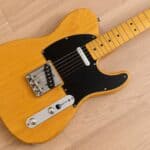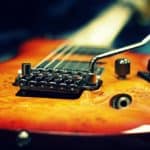What is a super strat actually?
I think nobody can define it clearly, and that’s the beauty of the concept.
Just any strat-shaped guitar that pushes the envelope in some way towards modernity can be labeled as one.
This is why there are many different Super Strats in the market, and each manufacturer puts its own set of spices in them.
Naturally, the materials with which they construct them are a very important factor of differentiation.
But, with all these variations what is the best wood for a super strat?
Super Strats were born as heavy modded Stratocasters so they took their tonewoods from that model: alder or swamp ash bodies, maple necks, and rosewood fingerboards. As the concept popularized, each manufacturer had its take on them, so they’re built with almost any possible tonewood combination.
In this article, I will discuss everything there is about the different tonewoods used in Super Strats through the years, and why manufacturers might choose one over the others.
After leaving this page, you will have a clear idea about what materials work well for a Super Strat, and why builders tend to have gravitated to a particular set of them over the last decades.
Are you ready to get started?
Let’s go!
What makes for a great tonewood
Although tonewoods are debated among guitar players, especially for electric guitars, I’m a big proponent that they actually do make a difference.
However, we are not here to discuss that now.
Assuming that tonewoods are important for a guitar, it’s only natural to also accept that there might be different “qualities” of them in the wild.
And, although this quality I mention can be used to rank specific types of wood, or species (or anyway it should be said) such as Alder, Swamp Ash, Maple, Cedar, Rosewood, etc. or their different local variants (Indian rosewood, Brazilian rosewood) I also think about it within slabs of the same kind.
You see, you can find two pieces of comparable trees of Alder, however, one has been cut very recently and the other one was stored for 70 years.
In this case, you can expect that the older exemplar will probably be way better “stationed”, dryer, and more resonant for the use on a guitar.
This is a big tradeoff a lot of manufacturers have to think about nowadays with the current availability of woods, but I will touch on this later.
Legendary Super Strats were built with alder, swamp ash, and maple
Super Strats, popularized by Eddie Van Halen’s Frankenstrat, in their origins were just heavily modded Stratocasters.
It’s natural then that their original tonewoods are just shared with the model that even gives them their name.
Alder and swamp ash for their bodies, combined with maple, and in some cases rosewood fretboards.
It can’t get better than that.
Or can it?
Actually, it’s just probably that we are used to the sound of this tonewood combination, and that it’s just a cultural staple we can’t escape from.
However, one can argue that Strats and Super Strats tend to sound nothing alike.
So how much do tonewoods influence their sound?
I won’t change teams at this point and claim that it doesn’t matter, but I will argue that one should have a global view of the different parts of a guitar and how they affect their tone.
Other alternatives
With time, and as the concept of a Super Strat became more popular and demanded by enthusiasts, the idea became a model itself, and almost every brand nowadays has its unique take on it.
This led to, perhaps, the broadest palette of materials used for a single guitar model (if you could consider the Super Strat as a single mode) among manufacturers.
From the most exotic woods with incredible figures to the cheapest alternatives such as poplar, basswood, cedar, or agathis.
Remember cheap doesn’t always mean bad. It’s just wood from a different kind of tree.
You can find Super Strats with mahogany bodies and figured maple tops, a combination popularized by Gibson, for instance.
Suhr moderns, another high-end alternative rocks basswood bodies with maple tops and necks, paired with roasted maple or pau ferro fretboards.
There are probably no tonewoods better than others for Super Strats and it mostly is a matter of looks, tone, and the quality of woods at the disposal of the builders.
Quality vs availability
As I mentioned earlier, these days, with mass production in mind, manufacturers and artisans have to deal with a ubiquitous tradeoff between quality and availability.
Making a guitar with its vintage old specs it’s not economically possible in many cases, and in some others, not even legal.
From finishes to certain protected kinds of woods, manufacturers have to make compromises to deliver goods at a payable price point.
Alder, for instance, is a type of wood in high demand, and its production can’t keep up with the market needs.
Remember a tree can take about 20 years to be ready for processing.
This only causes available stocks to be young and not really well-fitted for guitar making.
A completely different scenario from what Fender had to deal with in the early ‘50s when the Stratocaster was first prototyped, and the woods they chose to make it were among the most affordable and easier to come by.
One could argue that if such a guitar was designed in the current times, its builders will probably gravitate to some alternative kind of wood that is currently commonly available in conditions suited for guitar-making, such as the ones mentioned above.
Conclusion
There is no best single wood combination for a Super Strat because the concept allows for great variability between different brands’ takes. Original ones such as the Frankenstrat just were heavily moded Strats so they were built with ash or alder bodies, maple necks, and rosewood fingerboards.

Hello there, my name is Ramiro and I’ve been playing guitar for almost 20 years. I’m obsessed with everything gear-related and I thought it might be worth sharing it. From guitars, pedals, amps, and synths to studio gear and production tips, I hope you find what I post here useful, and I’ll try my best to keep it entertaining also.





